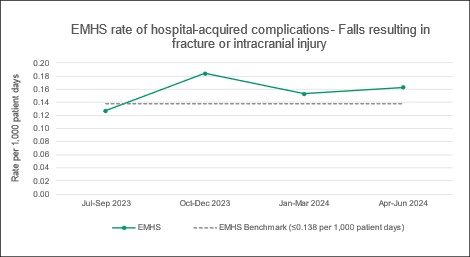Hospital-acquired complications – Falls
Each year nearly one quarter of people over 60 years of age will experience a fall. For some people, the injuries caused by their fall may be so serious that they can no longer live independently.
Falls account for over 80 per cent of all injury-related hospital admissions for people aged 65 years and older. They can occur at any age, but the frequency and severity of falls-related injuries increases significantly with age and frailty.
Falls are one of the most frequently reported clinical incidents in hospitals worldwide and are associated with increased:
- length of hospital stay
- care and use of health resources
- discharge rates to a nursing home or residential care facility.
Measuring hospital-acquired complications – Falls
The World Health Organization (WHO) defines a fall as an event which results in a person coming to rest accidentally on the ground, floor or other lower level. This definition covers all types of falls-related clinical incidents, including:
- near-misses
- intercepted falls where the patient is lowered to the ground
- suspected/unwitnessed slips/trips/falls
- witnessed slips/trips/falls.
Fall-related injury is one of the leading causes of hospital-acquired morbidity and mortality in older Australians, and leads to pain, bruising and lacerations and fractures. Falls can also lead to intracranial bleeding, which can cause confusion, drowsiness, clouding, loss of consciousness and headache.
Healthcare commonly uses rates to measure complications such as these. The number of patients who have a fall in hospital resulting in fracture or intracranial injury per 1,000 patient days.
How do we measure up
The graph below shows the combined rate of reported falls incidents for the EMHS hospitals:
- Armadale Health Service
- Kalamunda Hospital
- Bentley Hospital
- Royal Perth Hospital
- St John of God Midland Public Hospital
Chart: Rate of falls in hospital resulting in fracture or intracranial injury.

What the figures mean
The benchmark is less than or equal to 0.138 falls in hospital resulting in fracture or intracranial injury per 1,000 patient days. A rate lower than the benchmark is desirable.
EMHS rates were above the benchmark for three quarters out of the last four quarters. EMHS constantly strives to reduce the rate of hospital-acquired falls complications across all EMHS hospitals and preventative strategies continue to be put in place.

